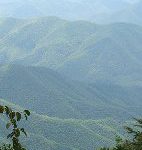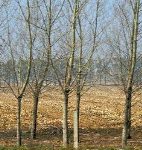In late March, the Chinese government published an outline of its 12th Five-Year Plan. Among its aims is the creation of 12.5 million hectares of new forest – increasing China’s rate of forest cover from 20.36% to 21.66% and adding an extra 600 million cubic metres of forest stock. It sounds like good news. But Yu Changqing, former head of the Ecological Protection Research Centre at Tsinghua University, has doubts about the value of this scheme.
Speaking at Beijing-based NGO Green Beagle in early March, Yu raised a number of questions: “Why is the environment continuing to worsen despite the increase in forest cover? Why are we continuing to create new forests, but retaining less than a quarter of them? Is it worth all the money and manpower? Have the experts at the relevant departments of the State Council and the Chinese People’s Political Consultative Conference considered this?”
Yu has acted as a consultant to the World Bank and WWF and, in the 1990s, worked in the statistics department at the Chinese Academy of Forestry. After participating in a national survey of panda populations as part of an expert commission, he wrote an article on the survey process, exposing shoddy work and fabrication of results.
In 2005, the local government and forestry bureau of Hudehudu village in Alxa Right Banner, an administrative unit of Inner Mongolia, designated the local area as public forest. Herders were banned from putting their livestock out to pasture and, when they ignored the rules, they were taken to court. But Yu has a question: how does grassland become “forest”?
He researched the case and found that, in 2000, the entire banner had around 171,000 hectares of forest – just 2.3% of its land. By 2009, this had increased more than five-fold to around 960,000 hectares, according to documents on related compensation payments. This included key forests subsidised by central government funds (where herding is banned) of 523,000 hectares, three times the area in 2000.
“Huge swaths of grassland have been declared ‘public forests’ – and ‘key public forests’ at that,” said Yu.
The state defines “public forests” as forests managed to protect and improve the human environment, maintain ecological balance, preserve genetic resources or contribute to scientific research, tourism or national security. It includes forests that provide shelter – for example from sandstorms – and can sometimes include scrub. However, some of the areas that have been blocked off to allow forests to grow do not meet this definition, said Yu, and are simply being used to bolster forest figures.
China’s rules for calculating forest cover allow “scrub forest” to be counted “according to state regulations”. But those regulations did not appear until 2004. Once formulated, they allowed scrub to be classed as forest in ecologically weak areas – such as arid regions with average annual precipitation of less than 400 millimetres – when it is used for ecological protection and has coverage of at least 30%. Alxa Right Banner does have less than 400 millimetres of precipitation, but for the scrub to be classed as forest, it still requires coverage of at least 30%.
Yu says that since 2000 – well before the regulations were in place – China has been including scrub in forest cover statistics. And, since the rules came into force, there has been no attempt to check the 30% rates, or even to clarify the policy: “How do you check? In which season? Before or after it has rained? Do you count grass? Different answers to these questions would give different results, but there are no regulations on how to do it.”
According to Yu, the only “benefit” is to the authorities concerned – the funding they receive for the forest projects and an apparent improvement in their performance. Meanwhile, on pastures no longer managed by herders, agricultural and mining activity is increasing, to the detriment of the land. In fact, this vegetation that the authorities call “forest” needs to be grazed to stay healthy.
Yu also has concerns about funding. State Forestry Administration (SFA) reports on six key projects from before 2005 indicate that, for each mu (around 0.7 hectares) of forested land, 100 yuan (US$15.3) was invested. If we assume a price tag of 300 yuan (US$45.9) per mu for the years from 2000 to 2009, to account for rising costs, then a total of 244.9 billion yuan (US$37.5 billion) would have been spent over the decade on creating 54.426 million hectares of forest – with an average annual spend of 24.5 billion yuan (US$3.7 billion). Investment in forest creation for those six major projects alone would have cost more than 30 billion yuan (US$4.6 billion), and that does not include money spent on relocating populations, foresters’ wages and so on. Actual spending for the years after 2005 has not been published.
After all of that investment, what was the result? Yu analysed SFA figures and found that, although 2.68 million square kilometres of forest had been created by 2009, only 22.9% of that has been retained. More than three quarters of the money spent has been wasted.
Yu believes that the root problem with the management of China’s forests is the extent to which the process is controlled by government: “The SFA manages the forest, it manages forest creation, it gets the money and it evaluates success. Forest inventories are carried out by a subordinate body, the heads of which are officials, not scientists. The results they publish are over-simplified – fine for public consumption, but scientists can pick any number of holes in them.”
China’s forest creation work is managed by the National Afforestation Committee, which is chaired by the vice-premier of the State Council, while the SFA director is deputy chair. At the SFA, there are a number of bodies involved in forest creation, including the Forest Creation Department, the Resources Department, the Natural Forest Protection Office, the Farmland Conversion Office, the State Forestries and Tree Seedlings Work Main Station and more.
“Forest coverage is, just like GDP, a measure of government performance,” said one former forestry worker.
However, Yang Fangyi, climate-change officer at NGO the Shan Shui Conservation Center said that there has long been international debate over the definition of forests and calculations of forest cover – and you cannot simply blame ulterior motives. For example, China’s standards for canopy density (the degree to which trees obscure the ground; a measure of forest density) are higher than those of the United Nations. But Yang pointed out that, unlike China, the UN’s definition for forests excludes commercial trees such as mangoes and artificially planted trees such as cork and rubber trees and coconut palms.
An official with the SFA who wished to remain anonymous explained that loosening the forest definition in areas unsuitable for trees allowed scrub to benefit from funding for forest protection. And after all, said the official, scrub still helps to prevent sandstorms, adding: “Even if we do increase the figures for forest coverage, it’s no big deal. The more the better, as the environment in those places will be protected as forest land.”
SFA figures show that China’s forest area and coverage started to increase rapidly in the early 1990s. By 2008, forest coverage was almost 2.4 times that of the late 1940s. By the end of 2009, more than 12.1 billion people had taken part in voluntary tree planting exercises, and over 56.3 billion trees had been planted. But rates of soil erosion and water loss have not improved; one million square metres of new land is affected each year. Forests may be expanding, but the environment continues to worsen.
Meng Si is assistant editor in chinadialogue’s Beijing office. Editorial assistant Zhang Yingying also contributed to this article.
Homepage image from binfen98


